Morgan Smith
“Look,” the Border Patrol agent said, pointing down the ridge towards Anapra, Mexico. We had driven up a steep dirt road on the US side of Monte Cristo Rey west of El Paso and Ciudad Juárez to a lookout point from which the Border Patrol could monitor groups of migrants gathering in Anapra for an illegal border crossing into the US.
Instead, we saw eight boys on the ridge below us all wearing masks and carrying cell phones.
“Cartel lookouts,” the agent said.
For about five years, I had been driving along the wall below us that separates Anapra from Sunland Park, New Mexico and giving dollars to Mexican families to stand on the Mexican side and pose for photos through the bars of the wall. It was a game. They recognized my car, knew our names and would come running to the wall.
“No more, Morgan,” the agent said. “They have a better job now with a cartel.”
Although Mexico’s President, Claudia Sheinbaum has been highly successful at apprehending high level cartel members and extraditing them to the US, this ongoing pipeline of young recruits will make it difficult to ever get the cartels under control. If you live in an impoverished border community like Anapra, however, what other options do you have? Continuing your education seems essential but what will it lead to?
Fortunately, we’ve just seen two positive projects.
On Friday, Sept. 12 we drove off the highway west of Ciudad Juárez and up a rough dirt street past an array of dilapidated shacks made of scraps of plywood and towards the one room school for Tarahumara Indians. The street was momentarily deserted but then suddenly full of kids running towards us. A crowd quickly gathered because they knew our car and that we always brought treats – oranges or Oreos or yoghurt.
Then a slender young woman appeared from the house next to the school. It was Lorena Solares who had been the teacher at this school for more than a decade before her reassignment to another school several years ago.
“I am back,” she said. “This is my school once again.”
Years earlier I had asked her if she missed her family in Chihuahua, Mexico. Pointing to the kids, she had answered, “This is my family.”
In recognition of the respect and affection the Tarahumara families feel towards her, enrollment in her school has increased from 18 students to 44.
Lorena with her drive and determination will now give these kids a chance to make something of their lives other than become mini-cartel members.
On Saturday, we were in Palomas at an orphanage, Las Alas de Amor where staff and volunteers were vetting students for scholarships for the upcoming school year. Tuition is free but there are other costs like textbooks, writing materials and uniforms that put a strain on the families in this impoverished community.
This program was founded by Jim and Pat Noble from Santa Fe more than 20 years ago. Noble was an immigration lawyer in Santa Fe but has retired and he and Pat now live in Texas. The two of them and their dedicated volunteers not only managed the orphanage but led the fight to build a public high school and now are helping kids with school costs through their scholarship program. About 130 kids participated in the 2024-2025 school year and weeks earlier the Nobles and others organized a ceremony whereby each scholarship kid who had completed the school year received a certificate, another way to reward their participation and encourage them to continue. I noted, however, that only two of the 130 were high school seniors.
For this year, they were anticipating 170 scholarship applicants and are searching for more sponsors.
Recently they expanded their program to include college applicants and I have sponsored three male students. Unfortunately, the first two dropped out, a major issue for young men along the border. It’s my hope that Pablo Ortiz, my current student will stick it out.
The younger kids were thrilled to be going back to school and to have this assistance but many of the older ones seemed apprehensive. We sat in on a briefing of the eight high school seniors. The goals are to have them graduate and then hopefully go on to college.
Raymundo Minjarez, the new director of Las Alas and Eunice Herrera, a lawyer from Santa Fe were counseling this group of seniors and making it clear that they could reach out to them if they needed support during their senior years. Eunice has been a key volunteer and board member for many years and was just named one of the “Forty under Forty” leaders by the Santa Fe Hispanic Chamber of Commerce.
I focused on one student, Juan Carlos Nieto Barrera who wants to be an architect. He looked nervous but determined. Maybe he will realize his dreams but he will obviously need support.
I see this all along the border – an early thirst for education and then a process of dropping out, especially among young men. It’s an obvious problem in the United States as well but the cost here on the Mexican border is higher because the alternative is joining a cartel.
These two programs are small steps but the dedication of people like Lorena Solares, the Nobles, Raymundo Minjarez and Eunice Herrera set an example that can make a difference.
Morgan Smith is a free-lance writer and photographer who travels to the border at least monthly to document conditions there and assist several humanitarian organizations. He can be reached at Morgan-smith@comcast.net.

